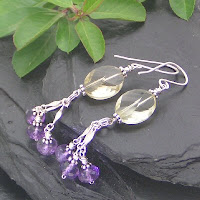
I often get asked if I use a professional to photograph my jewellery (now whether they are just being kind, is a different question!). And the simple answer is no, I do it all myself. I'm no expert by any measure and I rely on tools and a little bit of experimentation to get an acceptable shot. So I thought I'd share a couple of tips on what I've learned and what I use.
Firstly, as I mentioned above, I am no expert. But I do have experience of fiddling! So any guidance I offer is strictly fiddling expertise!
Probably the most important thing I've learned about photographing my jewellery is lighting. It's critical to get a decent shot. Sunlight is fantastic, but it's not always available and you can't always control for shadows or unevenness or unwanted tints etc. Then there's ordinary room lighting, which is seldom bright enough to adequately light your pieces - it's surprising how much light you need to be honest! I've tried various light boxes/tents, lights and assorted domes et al, but the one thing I've found that has given me consistent lighting has been my lightbox that I found on ebay about six years ago. I'm a big fan as it's small/portable with the lights integrated into the box and provides even and consistent light and light balance every time I use it. (this is
the one I bought, but there are a few others slightly less expensive available too). My work space is very compact so I really couldn't afford set-up that was space consuming. And I wanted to be able to photograph at any time without having to set up the box and lights etc. This one is as simple as turn the switch on and let it warm up. Plus, ss I mentioned I bought it nearly six years ago and have not had to change a light in it yet, it's been very cost effective.

The second thing I've learned is white balance. If you don't know what that is, take a little time to learn. There are lots of resources online to read up (
here's one I just googled, no endorsement). Basically white balance let's the camera "see" true colours, so that, for instance, white appears white rather than the yellow you sometimes see in photos taken under "normal light". Most digital cameras will have a manual white balance setting - learn to use it. It's also useful to understand a little bit about shutter speeds and focal lengths and iso - adjusting these can help give you greater depth of image. Though strictly speaking you probably could get away without them.
I use an old minolta digital with 2.1mp resolution. So it's not a high spec camera, but it does have the ability for manual adjustments to shutter speed and white balance. So you don't have to spend a lot of money on a fancy camera, just one that give you a bit of control of your camera. So there you have it, a coupe of tips. Hope they're useful!!







